How long-term cover cropping transformed a US farm’s soil
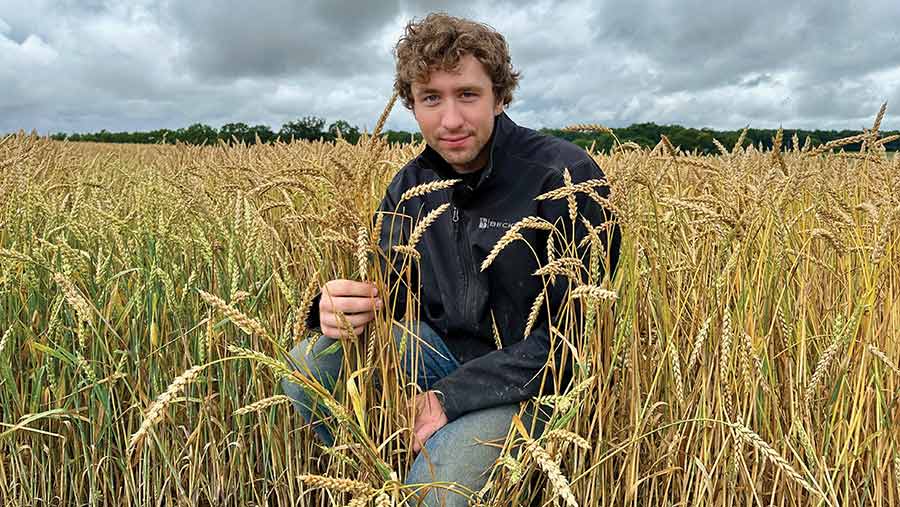 © Mike Abram
© Mike Abram In the Brandt Family Farm office, there is a collection of 15 soil cores taken from various fields across the farm with different soil types.
Most were taken in 2009, but there are three comparison cores taken in 2022 that help visualise the remarkable changes that multispecies cover crops have made to the soils on the Brandts’ 400ha farm in Carroll, Ohio.
When David Brandt first came to the farm in 1971, soil organic matter levels were just 0.75%, but under his management they reached 8% – an improvement visible in the darker soils in the newer soil cores.
See also: How US farmer increases profitability through relay cropping
He started practising no-till in 1971 and introduced single-species cereal rye cover crops in 1976 when he noticed yields decreasing.
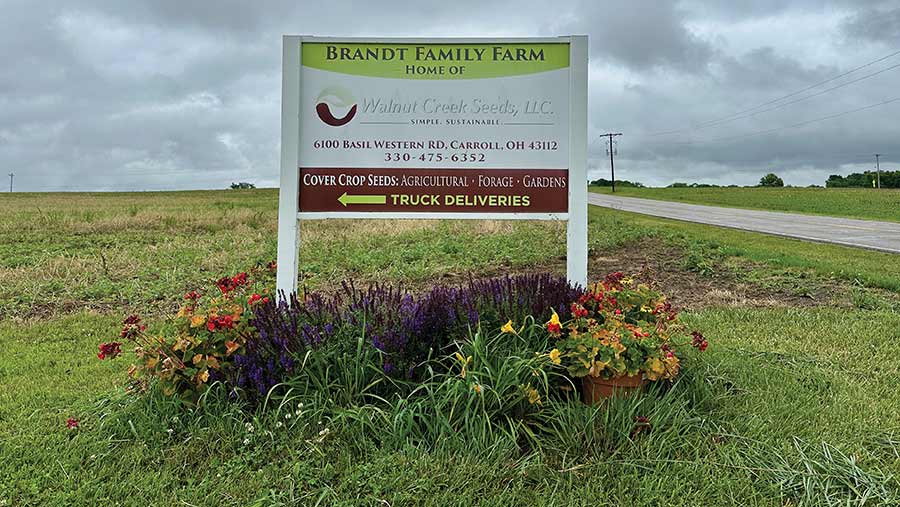
© Mike Abram
Godfather of soil health
His success in making both practices work on the farm is just one of the many reasons David Brandt became known as the “Godfather of soil health” in US regenerative agricultural circles, and why growers from across the US and around the world have flocked to his farm and his field days.
He even became the subject of a popular social media meme after saying about his career: “It ain’t much, but it’s honest work.”
Sadly, David passed away as the result of a motor vehicle accident last May, leaving his grandson Chris to take over management of the farm.
Cropping
Chris has been full-time on the farm since 2017. In common with most farms in the Midwest states, he grows corn (maize) and soya beans.
A little less common, the farm has 20% of its area under winter wheat, which has become a key crop on the farm, helping provide the time for a multispecies overwintered cover crop to develop ahead of the following season’s corn.
“A lot of farmers double-crop soya beans by planting them into wheat stubble,” Chris explains.
“We do a bit of that, which gives an immediate monetary return, but we also want to get the later return from planting a cover crop ahead of the corn.”
With wheat harvest in early July, multispecies cover crops have plenty of time to grow, leading to the high-biomass covers that regenerative farmers in the US have become famous for.
“These are the crops that make the difference to organic matters,” Chris says.
While David had been using cover crops since 1976, it wasn’t until he met cover crop advocate Steve Groff and North Dakota farmer Gabe Brown in the early 2000s that he started experimenting with cover crop mixes of six to 10 species.
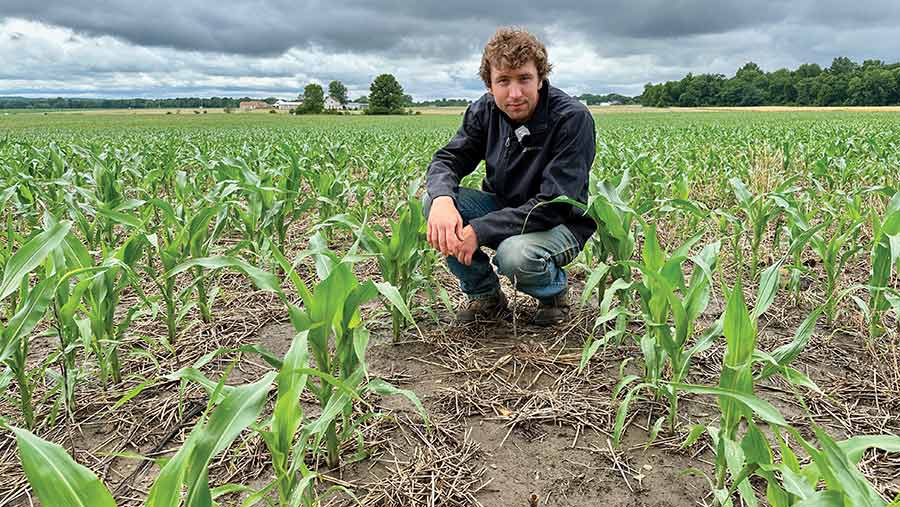
The Brandts’ maize crop © Mike Abram
Soil health
“Fields that are now 8% organic matter were only sitting at 3-4% back then,” Chris says. “If you use monocrop covers, whether it’s buckwheat, rye or clover, you won’t see a strong increase in organic matter.”
Increasing organic matter provides a lot of benefits in the field, such as improved soil structure and water holding capacity, he says.
“For each percentage point of organic matter, you can hold significantly more water in the soil, and if it can hold water, it can also infiltrate.”
His soils can infiltrate 9in (22.8cm) of rain an hour, so it takes a very significant rain event to trigger surface erosion, and because of that, it also reduces nutrient loss.
“Between the improved soil structure and increased rain infiltration, we can get machinery on fields after rain significantly sooner than our neighbours,” he says.
Another benefit is increased biological activity. “We have more mycorrhizal fungi, which as a network help bring nutrients to plant roots, so plants are better able to utilise applied nutrients.
“Generally, in the US, it’s said one pound per acre of nitrogen in a corn field will lead to one bushel per acre of corn.
“What we see [on the Brandt farm] is that one sixth of a pound of nitrogen becomes one bushel of corn, so we’re more effective at getting those nutrients to the plant,” Chris says.
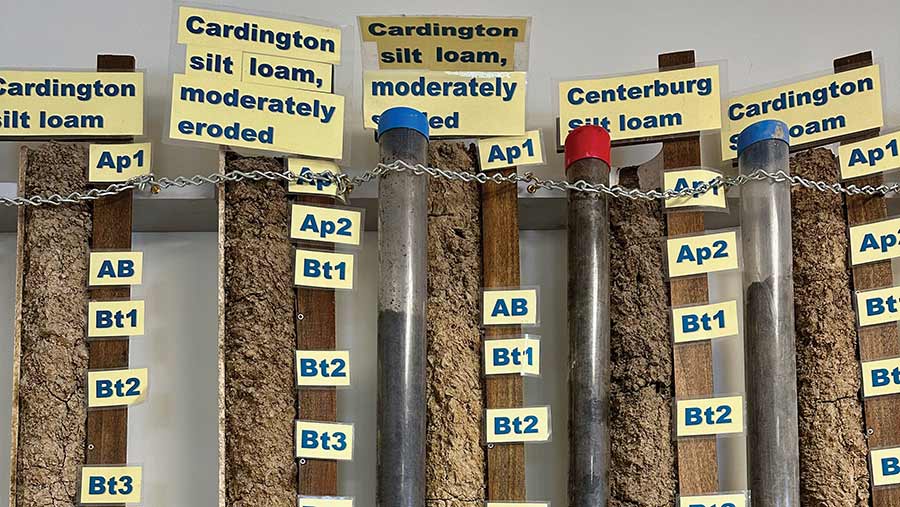
The soil cores charting the farm’s progress © Mike Abram
Grazed cover crops
Perhaps surprisingly, though, last winter was the first time the Brandts had experimented with grazed cover crops using 250 sheep owned by a neighbouring farmer.
“There’s not that many sheep in this region, and we don’t really want to put cows on a field going into corn the next year,” Chris explains.
“But the biggest problem is not having any fences, and it’s hard to justify putting them in.”
The sheep mob-grazed various sections of the field for two to three days from the end of November to early January, with Chris keen to see if the benefits from sheep grazing outweigh the potential disadvantages from losing biomass and possible compaction.
The core components of the farm’s typical cover crop mix before corn are cereal rye, hairy vetch and crimson clover.
These generate large amounts of biomass, suppressing weed growth and shading the soil from the sun, while the legumes also fix nitrogen to reduce fertiliser inputs.
Sunflowers, pearl millet and flax are added to mixes where the farm is looking to promote mycorrhizal fungi propagation on newly aquired land, to add feed value for grazing, or to increase micronutrient content in the topsoil, Chris explains.
“Sunflower roots will pull zinc up from areas where corn roots won’t normally reach,” he says.
But the sheep trials are pushing him to try more specialised mixes containing Sudan grass (a relative of millet), oats, forage radish and grasses that will provide better feed and nutrition for the sheep.
“What mix to use depends on what kind of practice you’re aiming for,” he says.
Cereal rye
Simpler cover crops are used ahead of soya beans, the other spring crop in the rotation, but play an equally important role.
These covers follow corn harvest in October or November, which means they are planted later than when following wheat, restricting selection of species to mostly cereal rye or other cereals.
Cereal rye has the advantage of a much larger root structure than wheat, and it seems to have either an allelopathic or competition effect on mare’s tail, a key weed of soya beans.
“It’s one of the hardest-to-control weeds in soya bean, so the fact cereal rye seems to almost completely displace it is a significant reason to use it,” Chris says.
Benefits from cereal rye are apparent from planting dates until Christmas, “but you don’t get much growth if you plant it past the third week of November, so it’s usually planted by then.”
Growing a cereal rye cover generally leads to an increase in soya bean yields of 3-5bu/acre (0.2-0.33t/ha), Chris says.
“Soya beans require 2-4 units of nitrogen for every bushel they produce, and usually it nodulates to generate two to three of those.
“So the more nitrogen you have in the ground, the lazier the soya beans are, and they won’t nodulate as much, which reduces yield.
“The theory is the rye takes away nitrogen from the soil and forces the soya beans to nodulate more, increasing the base yield.”
Another important role for the terminated rye is protecting the soil from the area’s high summer temperatures, which can reach 35C or more.
“It causes all biological activity in the soil to cease, including plant root growth,” Chris says.
Typically, the rye cover, like the multispecies version after wheat, is planted with a Kuhn (Krause) direct drill, although in some years when time is short Chris will spread cereal rye seed through a fertiliser spreader.
“You can do more acres per hour, but the stand can be thinner.”
The soya beans are then planted into the cover before termination, usually with a crimper-roller.
“We’ve found if you terminate early and get rain, which is common, the ground gets wet and, with the rye laid over, the wind cannot get in to dry the soil, and you get a wet, sloppy mess.”
Crimper-roller termination after drilling works well as long as the cereal rye has begun flowering, when breaking the stem will kill the plant, Chris says.
Rolling also helps ensure any open seed slots from the direct drill are closed, improving germination.
Can compost extracts replace synthetic nitrogen in wheat?
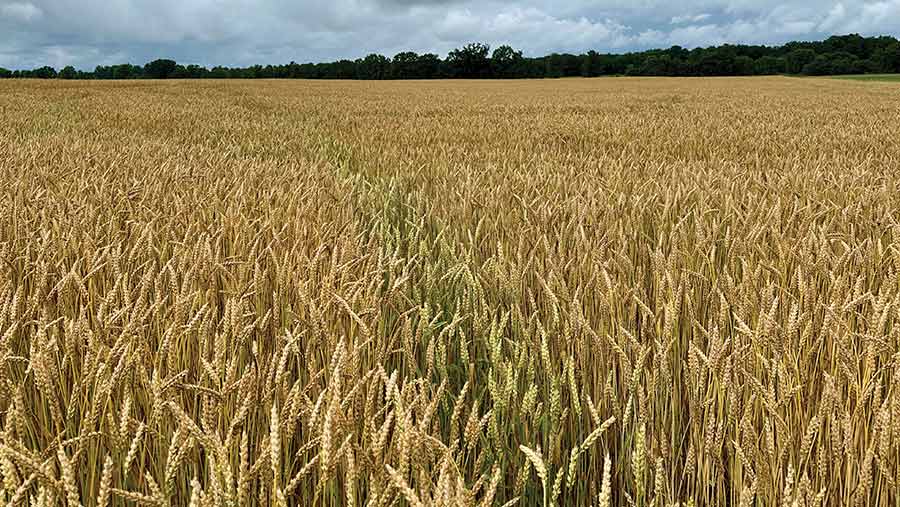
© Mike Abram
Two different compost extracts are being trialled on one of Chris Brandt’s soft red wheat fields to see whether they can replace the synthetic nitrogen fertiliser typically applied.
The extracts have been made using different systems and recipes that were demonstrated at a Brandt Family Farm soil health day in April.
One was a compost tea made by the Dresbach family, who also farm in Ohio, using seaweed, molasses, rock salt and a few other ingredients, Chris says, while the other was made using the indigenous microorganism solution (Imos) developed by North Dakota farmers Kelly and DeAnna Lozensky.
Imos extracts use a base material from the farm – some soil from under apple trees, a wood and a creek bank – before being brewed using a process and a microorganism food developed by the couple.
A third control plot was treated with the usual farm standard practice of 30lb/acre (33kg/ha) of urea ammonium nitrate (UAN).
All the various treatments were applied in early April at the end of tillering.
Very little visual difference was observed during the growing season, Chris says. “You could walk down the entire field and not being able to tell what was treated in the various 90ft (27.5m) strips.”
However, at harvest there was a clear advantage for the Dresbach compost tea treatment over the Imos.
The compost tea averaged 110-124bu/acre (7.4-8.3t/ha) compared with 70-90bu/acre (4.7-6.1t/ha) for the Imos, Chris says.
“The indigenous microorganisms aren’t a true fertiliser, and thus did poorly in comparison.
“I suspect this is because the indigenous microorganisms make excess tied-up nutrients more available to plants, but because our practices already work in this direction, there were less available nutrients for the IMOS to work with, although I don’t have anything to prove that.”
Perhaps more importantly, the compost tea yields just beat the standard UAN fertiliser treatment, he says. “I imagine we will be using much more compost tea as a wheat fertiliser in future.”
Chris is also planning to test the Imos as a seed treatment rather than a foliar fertiliser, and is currently trialling the compost tea as an in-furrow starter fertiliser for corn.
Cover crop and flour businesses add value
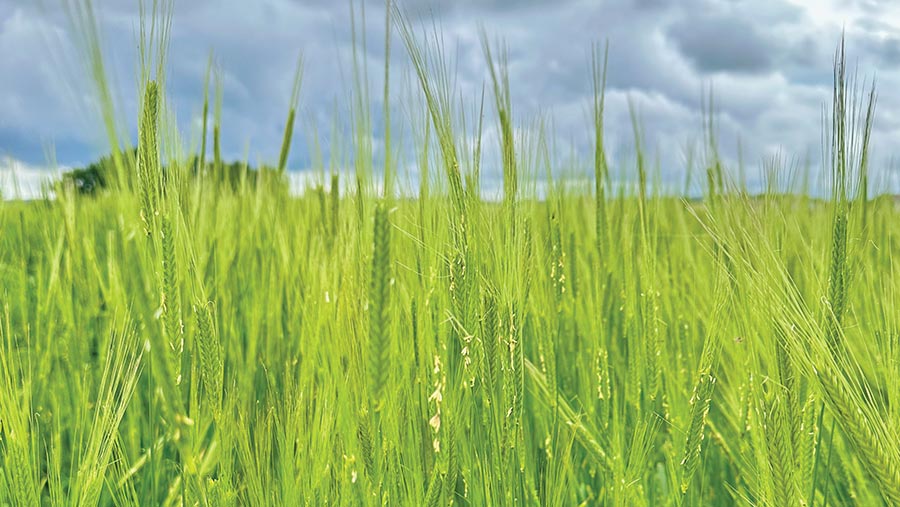
Einkorn wheat © Mike Abram
Two side businesses bring significant income and add value to Brandt Family Farms – a cover crop seed business, Walnut Creek Seeds, and a flour milling business.
Walnut Creek Seeds started in 2013 when farmers kept asking David where they could buy cover crop seed, Chris explains.
Run by his parents Jay and Ann, the business now sells about 50 different cover crop species either separately or in blends.
“About 60-70% of the business is custom blending mixes for farmers depending on what they need in their particular fields,” he says.
Virtually all the cover crop seed is bought in from other growers. “Things like fescues for sheep grazing or clovers don’t grow very well in Ohio, so we have to bring that in from the West Coast, while oats and cereal grains come from the Canada or the plains.”
Other seeds, such as sun hemp, come from Indonesia, while other species are imported from Europe. “The business makes a higher margin than the farm,” Chris says.
While little of the Brandts’ own crops end up being sold as cover crop seeds, they are adding value by milling various grains to sell to bakeries, as well as direct to consumers.
“We sell around 2.25t every fortnight currently,” Chris says, but that potentially could increase dramatically with one customer looking to significantly increase its order to 12t/week, which would require a larger mill.
With milled corn flour for brewing worth up to $50/bu (£1,470/t) compared with corn grain at $6.30/bu (£184/t), it’s a significant value addition.
One of the wheat varieties the farm is growing is Einkorn – an ancient wheat that was one of the first varieties to be domesticated – after a baker bought a local bakery and found two drums containing seed.
“The drum had a label that said 1911 on it. We don’t know if that is the year the barrel was sealed, but they brought it to us and said could we grow it.
“And it grew pretty well. So we’ve just been saving some seed, and growing it ever since as apparently it sells.”
50 years of progress on Brandt Family Farm
- 8.7% average soil organic matter on home farm in 2022, compared with 0.75% in 1971
- 75-80ppm phosphorus levels in 2022 (38ppm in 1971)
- 300-500ppm potassium in 2022 (90ppm in 1971)
- 1.6m litres of water/ha infiltration (234,000 litres/ha)
- 100kg/ha nitrogen applied to corn (168-280/ha up until 1989)
- No longer uses fungicides, insecticides or seed treatments
- Yields increased by 5% between 2015 and 2020; now holding steady
- Corn yields average 12.4t/ha; up to 14.8t/ha in higher rainfall years
- Corn direct costs £393/ha (versus £875-925/ha average in the region)
- Soya bean yields 4.37-5.5t/ha
- Soya bean direct costs £340/ha (versus £778/ha regional average)
- Wheat yields 6.73-7.4t/ha
- Input costs down 72-78% between 2009 and 2022
- Diesel use 22.5 litres/ha a year (versus 237-281 litres/ha a year average)
- Other farmers report fuel bills cut by 9-13% in two years after introducing cover crops

